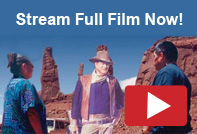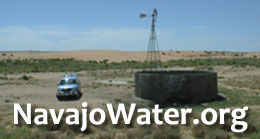Groundswell Educational Films issued the following press release:
FOR IMMEDIATE RELEASE
September 24, 2008
Documentary about Navajo Family Exposes the Human Cost of Nuclear Waste Contamination, Triggers Investigation and Warnings about Nuclear Dangers
WASHINGTON D.C. — While the nation is abuzz with talk of energy independence and nuclear reactors, the legacy of cold war uranium mining remains an open wound that literally continues to poison residents of the Navajo Nation.
A Navajo grandmother, who is a main character in the documentary The Return of Navajo Boy, came to Capitol Hill today, to share her story with congressional leaders in a screening hosted by Tom Udall (D-NM), Rick Renzi (R-AZ), Jim Matheson (D-UT) and Navajo Nation’s Washington Office. “I was an extra in Hollywood western movies and a nameless Navajo Girl in postcards. There are thousands of pictures of my family and me. But we never got a chance to say anything. Until now,” said Navajo grandmother, Elsie Mae Begay. “I want people to know how uranium has affected us. That’s why I travel with the film.”
The film will be screened with a new epilogue that documents Ms. Begay’s courageous journey with the film. The screening and discussion will be held Sept. 24, 3-5 PM, Cannon House Office Building, Room 122. The event is free and open to the public. A second free public screening is scheduled for Thursday, Sept. 25, 6-8 PM at Georgetown Law, Gewirz Student Center, 12th floor, 120 F Street, NW (between 1st and 2nd Streets). Several lawmakers and high-ranking officials from the EPA, Department of Energy and other government offices are expected to attend the screening.
The Return of Navajo Boy was produced and directed by Jeff Spitz of Groundswell Educational Films. Groundswell’s outreach campaign triggered a federal investigation of uranium houses. Ms. Begay’s story, picked up by Los Angeles Times, motivated Rep. Henry Waxman (D-CA) to bring the issue to the Committee on Oversight and Government Reform which mandated a clean-up plan by the five federal agencies that are responsible for uranium contamination. “This has been a bi-partisan failure for 40 years,” said Congressman Waxman at the opening of the hearings.
Ironically, the Comprehensive Five-Year Plan, issued jointly last month by the U.S. Environmental Protection Agency, the Department of Energy, the Bureau of Indian Affairs, the Indian Health Service and the Nuclear Regulatory Commission, does not include Ms. Begay’s homestead.
“Ms. Begay tells her story through this film, which creates a pathway for people outside her culture to connect with her,” explained Groundswell co-founder, Jeff Spitz. “We book the film and Ms. Begay in public screenings to open doors for face-to-face contact with reporters, academics, funders, policymakers and others who can help make a difference in addressing radiation clean up on Navajo lands.”
“We need people in Washington to realize the enormity of the problem,” said Dave Taylor, an attorney for the Navajo Department of Justice. “We are grateful for the attention Congressman Waxman has brought to this issue, however follow up on the ground has been minimal. We need a permanent solution, not band-aids. The waste needs to be dug up and put into safe repositories.”
“Groundswell’s approach to advocacy shows how one story can ripple into another and keep moving on to cause change,” said Judy Pasternak, the LA Times reporter who wrote the four-part series about uranium poisoning on the reservation. Ms. Pasternak met Elsie Begay at a Groundswell screening. Ms. Begay’s story of raising her family in a house made from uranium became the framework for the opening piece of Pasternak’s investigative series about uranium.
The Return of Navajo Boy is one example of Groundswell Educational Film’s non- profit mission. Groundswell gives voice to those often overlooked by mainstream media; uses film to initiate cross-cultural dialogue; creates public engagement campaigns; and build alliances with stakeholders to achieve social change. “ We will continue to film this journey until Ms. Begay’s uranium situation is resolved,” Spitz added. To learn more about Groundswell’s work on this and other projects, visit www.groundswellfilms.org.
For more than four decades, Navajo Nation soils were dug and blasted to produce millions of tons of uranium for America’s nuclear arsenal. Residents today still breathe radioactive dust, drink contaminated water and live in homes contaminated by radiation. There are nearly 1000 abandoned uranium mines on the Navajo reservation.
Additional screening co-hosts include National Resource Defense Council, Georgetown Environmental Law Society, Georgetown Law, Georgetown American Constitution Society and the Raben Group. The Bradshaw-Knight Foundation sponsored the events and epilogue.
###














Leave a Reply
You must be logged in to post a comment.